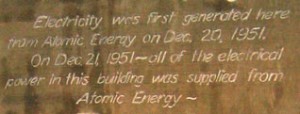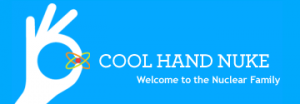Social media and nuclear energy
It's not the same as selling donuts, cars, or promoting sports entertainment

EBR-1 chalkboard ~ the 1st known nuclear energy blog post 12/21/51 on the Arco desert of eastern Idaho
As blogger on nuclear energy for the past five years, I realize I'm writing on a niche subject that isn't going to pull in millions of readers. Unlike some entertainment blogs, a site on nuclear energy is never going to be able to link the words "reactor pressure vessel" with the antics of a Hollywood celebrity at a New York night club. So, what can be said about the use of social media and how it has evolved as a new communication tool in a mature industry?
Evidence of acceptance of social media is widespread, with the most recent example being the launch of the Nuclear Information Center, a social media presence by Duke Energy (NYSE:DUK). Content written for the Nuclear Information Center by a team of the utility's employees is clearly designed to reach out to the general public. This effort goes beyond the usual scope of a utility Web site, which includes things like how to pay your bill online, where to call when the lights go out, and so forth.
The Nuclear Information Center announces right at the top that "In this online space, you will find educational information on the nuclear industry and the nuclear stations operated by Duke Energy. We will feature insights into radiation, new nuclear, emergency planning and more . . . allowing readers to get an inside view of the industry."
That's a big step for a nuclear utility. The reason is that like many publicly traded electric utilities, it generates electricity from several fuel sources, including coal, natural gas, solar, wind, and nuclear. Because these utilities have huge customer rate bases and supply chains, they are inherently conservative about the information they publish on their Web sites. Also, there are significant legal and financial reasons why a utility might or might not put information out there for public consumption. Press releases receive scrutiny from the general counsel and chief financial officer for very important reasons having to do with regulatory oversight and shareholder value.
Different approaches to blog rolls
Duke's Web site is a completely modern effort set up like a blog, with new entries on a frequent basis. On the right column, the site has a list of other places to get nuclear energy information, including the American Nuclear Society (ANS), the Nuclear Energy Institute (NEI), and the Nuclear Regulatory Commission (NRC).
While even the NRC now has a blog, going beyond information about its operations in terms of content may be a stretch for the same reasons that Duke is cautious about links on its site. It is probably too much to expect Duke, or any other nuclear utility, to list any of the nuclear energy blogs.
Most nuclear blogs have a "blog roll"which list other publishers of information on the nuclear energy field. Areva has done this on its North American blog. Areva handles the issue of avoiding any appearance of endorsement by noting that the list with more than two dozen entries is one of "blogs we read." Areva also has several years of experience reaching out to the nuclear blogger community with monthly conference calls.
The blog of the Nuclear Energy Institute, NEI Nuclear Notes, lists a wide range of nuclear blogs including this one as well as the blogs published by independent analysts.
Who reads nuclear energy blogs?
So, who is reading nuclear blogs? On the ANS Social Media listserv, I asked this question recently and got some interesting results for the month of May 2011. Here's a sample of the replies:
- Michele Kearny, at the Nuclear Wire, a news service, reports for the month of May 18,812 page views. Michele's blog is a fast-moving series of news links that keeps readers coming back for updates.
- Will Davis, at Atomic Power Review, who has been publishing high quality, in-depth technical updates about Fukushima, reports 31,613 page views for the same month.
- Rod Adams, who recently updated the template at his blog at Atomic Insights, reported his numbers in terms of absolute visitors. He cites Google Analytics as reporting 10,583 unique visitors for May. Rod emphasizes commentary and analysis across a wide range of nuclear subjects.
- At my blog Idaho Samizdat, I can report 6,945 visitors and 24,938 page views for May 2011. The blog covers economic and political news about nuclear energy and nonproliferation issues.
- At ANS Nuclear Cafe, this blog uses Wordpress to track readers, reporting 24,476 page views for the same four-week period as the other blogs. During the height of the Fukushima crisis on a single day, March 14, 2011, the blog attained over 55,000 page views as people poured on to the Internet in search of information about the situation in Japan.
Taken together, the four blogs that reported monthly page views represent 100,000 visits to online information pages on nuclear energy or an effective rate of well over 1 million page views per year. These are real numbers and the data are just for a small sample of the more than two dozen blogs on nuclear energy that update at least once a week.
Another interesting set of statistics is who reads North American blogs overseas? It turns out that the international readership is concentrated in a small group of countries. They include, in alphabetical order for the same sample of blogs, the following countries:
- Australia
- Canada
- France
- Germany
- India
- Japan
- United Kingdom
Who else invests in social media?
 The importance of social media has been recognized for several years by investments in it by organizations such as the Idaho National Laboratory, Areva, and recruiter CoolHandNuke.
The importance of social media has been recognized for several years by investments in it by organizations such as the Idaho National Laboratory, Areva, and recruiter CoolHandNuke.
A huge group of more than 5,000 people interact on LinkedIn, moderated by nuclear industry consultant Ed Kee. It is called "Nuclear Power Next Generation" and is one of dozens of such groups related to nuclear energy on the professional networking site.
Facebook anyone?
Nuclear energy is not so widely represented on Facebook as on LinkedIn, despite its enormous popularity, and isn't conducive to the kinds of technical dialogs that populate other nuclear social media sites. While the Facebook format is attractive to lifestyle information such as dating and the promotion of entertainment, sports, and consumer packaged goods, it doesn't seem to work as well for business and engineering topics.
It turns out Facebook is a good way to offer a "soft sell" for recruitment purposes to drive traffic to nuclear energy organization recruitment pages. It can answer the questions of what's it like to work for an organization and the attractive amenities of life in the employer's home town. Videos and photos can help deliver these messages.
Everyone is on Twitter
On the other hand, Twitter, even with its limits of 140 characters, is enormously useful for the nuclear energy field. Twitter users who follow the output of nuclear bloggers number in the tens of thousands, and many nuclear energy organizations, including the major utilities such as Entergy, have invested in a Twitter account to have a presence on the service. The American Nuclear Society "tweets" under @ans_org and posts updates daily on the situation at Fukushima
Traditional media meets social media
 The mainstream news media has taken notice of the use of social media in the nuclear industry by reading the nuclear blogs and also by following them on Twitter. Has it made a difference in how the media covers the industry? To some extent, there is evidence that the national dialog on Fukushima and the future of nuclear energy, as covered by the media, was better than if social media was not used by the nuclear industry.
The mainstream news media has taken notice of the use of social media in the nuclear industry by reading the nuclear blogs and also by following them on Twitter. Has it made a difference in how the media covers the industry? To some extent, there is evidence that the national dialog on Fukushima and the future of nuclear energy, as covered by the media, was better than if social media was not used by the nuclear industry.
Web sites maintained by NEI and the World Nuclear Organization had to make fast upgrades to their computer servers to handle millions of inquires from the media and the public and on a global scale. Getting out the facts of the situation to respond to these inquiries was facilitated by this online presence at an unprecedented scale.
Even so, newspapers often had anti-nuclear groups on speed dial early in the crisis and their voices reached an unsettled public with messages of fear, uncertainty, and doubt. In response, ANS used technical experts on its social media listserv to information media engagements, which reached millions of views on network television and major newspapers like the New York Times and Washington Post.
This useful mix of free form communication on the listserv and excellent outreach by Clark Communications, working for ANS, made a difference in getting the facts about Fukushima to an understandably anxious public.
 Margaret Harding, a consulting nuclear engineer with deep experience with boiling water reactor fuels, was one of the people tapped by ANS to be a spokesperson for the society. She wrote to me in a personal e-mail that social media made a difference for her in many ways.
Margaret Harding, a consulting nuclear engineer with deep experience with boiling water reactor fuels, was one of the people tapped by ANS to be a spokesperson for the society. She wrote to me in a personal e-mail that social media made a difference for her in many ways.
In summary, she said that it would have been impossible for her to fulfill this role without many hands helping her from various quarters at ANS.
She pointed out that the ANS Social Media listserv group "provided invaluable background information . . that helped me keep up-to-date and ready for the question from the next reporter."
In fact, she said, she might not have even started down this road if the listserv hadn't already proven itself as a source of information and expertise.
Another take on the news media's shift into anti-nuclear skepticism following Fukushima comes from Andrea Jennetta, publisher of Fuel Cycle Week. Writing in the March 17 issue, she said that this time the "bunker mentality" that has characterized communications in prior years by the nuclear industry gave way to something new.
" But instead of rolling over, the nuclear community for once is mobilizing and fighting back. I am impressed at the efforts of various pronuclear activists, bloggers, advocates and professional organizations.
But instead of rolling over, the nuclear community for once is mobilizing and fighting back. I am impressed at the efforts of various pronuclear activists, bloggers, advocates and professional organizations.
In the U.S., I have to commend the Nuclear Energy Institute and American Nuclear Society, as well as a dedicated band of individuals first connected by social media and now forever bonded like soldiers in war, for being proactive in offering up an antidote to the poison spewed by the mainstream media and the antinuclear lobbyists."
Engineers need soft skills
 Engineers aren't always comfortable with the soft skills of dealing with the news media. Blogs and other forms of social media, however, are the medium of information exchange for the next generation of leadership in the nuclear industry.
Engineers aren't always comfortable with the soft skills of dealing with the news media. Blogs and other forms of social media, however, are the medium of information exchange for the next generation of leadership in the nuclear industry.
For instance, North American Young Generation in Nuclear (NA-YGN) told a group of nuclear energy bloggers just last week that it recorded 80,000 hours of volunteer time for its members in the past 12 months, and of that number, 36,000 hours were related to public information outreach. NA-YGN has a formal program to train its 7,000 members in 90 chapters how to talk to the public and the news media.
Recruitment and retention of the next generation of nuclear energy leaders to participate in its future will require the industry to clearly demonstrate it has mastered and integrated these technologies into its operations. It appears from the use of social media in the response to Fukushima that the nuclear field is rising to the occasion.
________________________________________________
Dan Yurman publishes Idaho Samizdat, a blog about nuclear energy, and is a frequent contributor to ANS Nuclear Cafe


